Table of Contents
Off to Asia (Kyle)
For two weeks in November, Kelly and I traveled to China and Cambodia. We had a few motivations: to visit some of Kelly’s family members, to see the country my mom is from, and to eat great food. Kelly wrote about our travels in China, while I wrote about Cambodia. Although this is not your typical “Climber Kyle” post, I hope you enjoy learning more about our travels and culture!
China (Kelly)
Shanghai
We landed at the Shanghai Pudong airport and passed through the border inspection. Kyle had practiced introducing himself to my relatives by saying “I am Kelly’s boyfriend,” and he accidentally told the border agent (about me) “She is my boyfriend.” We all got a good laugh out of that!
My cousin YuanYuan was waiting for us in the airport, and we all took a taxi together to a hotel near where she lives. We were absolutely STARVING and ordered 8 dishes for 3 people at a nearby restaurant called “Old Fat Cat.”

Huzhou
The next morning, we took a taxi to Huzhou to visit my grandma for her 91st birthday! It was honestly a complete coincidence that our travel schedule worked out perfectly. I’m not entirely sure if that was her solar or lunar birthday, especially since most Chinese people didn’t use the solar calendar until maybe the last 60 years or so.

We also visited Tai Lake and saw the Sheraton hotel that my dad says looks like a toilet seat. There were also several huge hotels under construction nearby, which led my aunt to comment “who’s ever going to stay there? It’s not like Huzhou is even a touristy city, like Hangzhou.” Which was just the first of many examples we saw of somewhat pointless Chinese investment in construction / infrastructure that will definitely be underutilized.

My aunt and uncle took us to the train station in Huzhou, where we boarded a train to Hangzhou. Kyle had never been on a high-speed train before – this one was actually a “D” class train (动车), which is the second tier of Chinese high-speed trains. But it still got up to an impressive 250 km/hr (over 150 mph) on a short 30-minute ride. And the train ride was so smooth!
Hangzhou
After arriving at the Hangzhou train station, we took the subway to our hotel. It’s pretty cool to see how well-integrated the different infrastructure is with each other – you walk out of the train station, and there are signs – including in English – telling you where to go for the different subway lines.
Our hotel was very close to the famous “West Lake” (西湖) of Hangzhou, and the streets were absolutely bustling with people. We had heard from my dad that the “musical fountains” were a fun display, but we needed to get there early so that we could get a good view. The show is totally free to the public, but you just stand on the (super wide) sidewalk in front of the lake, so if you’re a few rows back, your view gets somewhat blocked by people in front of you. Someone overheard us speaking English while we were shivering waiting for the show to start, and he started chatting with us. Turns out he’s a student at Zhejiang University but grew up in Toronto, Canada, and loves coming to see the musical fountain show every week. He even sang along with all the songs, which was pretty entertaining.
The next day was our only full day in Hangzhou, so we walked around West Lake and saw all of the touristy spots, including the Leifeng Pagoda (雷峰塔).

We also took the ferry to this island called 三潭印月 (“Three Pools Mirroring the Moon”) which is essentially an island in a lake that has 4 lakes in it. Essentially, the shape of the island is like the Chinese word 田, where the white spaces were little ponds. The image on the back of the ¥1 bill is also from a vantage point on this island, so we took a classic touristy shot.

We were quite impressed with how clean everything was, and it seemed to be largely due to the efforts of a very large amount of street sweepers. Labor costs in China are low enough that they really can just pay for people to sweep up trash in all the most popular scenic areas to make them clean and tidy.
Chengdu
My mom’s family is from Chengdu, and a lot of her siblings and cousins still live there – so it’s always a treat for me to go back and eat all the 麻辣 (numbing and spicy) food! Unfortunately, Kyle’s digestive system didn’t love all the spicy, oily, food as much as mine did, and he made good use of the traveler’s diarrhea medicine that his sister gave us.

After arriving at the hotel, we spent a couple hours wandering around at 宽窄巷子 (wide and narrow alleyways) which looks like a little neighborhood with traditional architecture, where all of these buildings are now tourist trap shops. There was a cool street performance by a guy who was extremely good at doing the limbo.

The next day, we visited 青城山 (Qingcheng Mountain), the birthplace of Taoism. I’ve been there almost every time I’ve visited Chengdu, and it was fun to hike up the sometimes-alarmingly-steep stairs and see all of the Taoist temples in the mist.


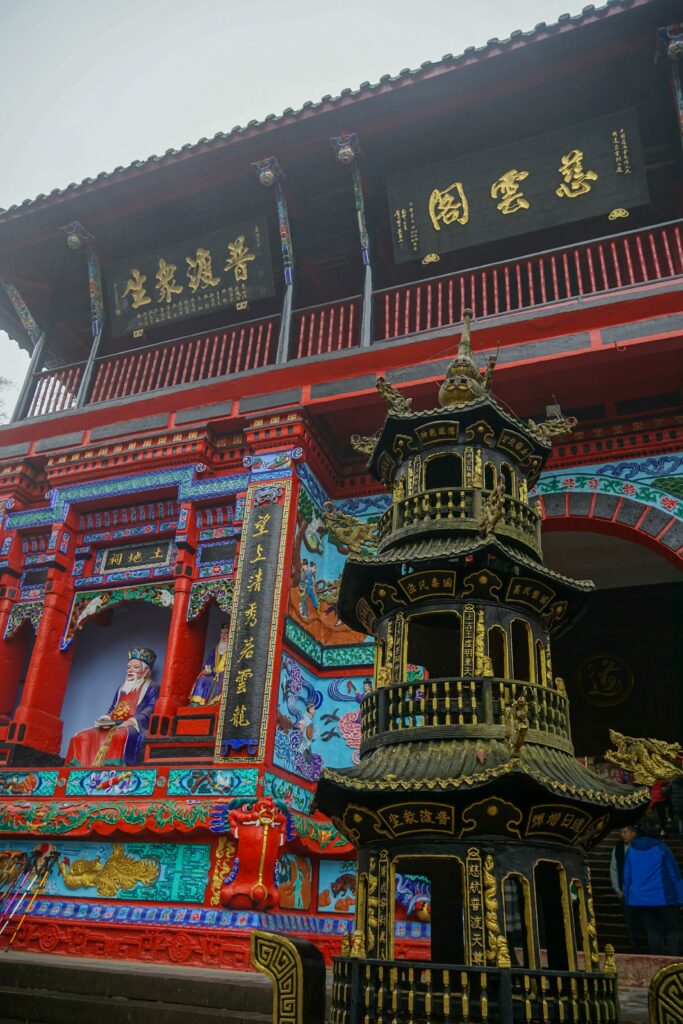
That afternoon, we took a short taxi ride to 都江堰 (Dujiangyan Irrigation System). This was an ancient irrigation system constructed in 256 BCE. In other words, by the year 0, this irrigation system was older than the United States is today. Before the construction of this irrigation system, the silty glacial-fed rivers of Sichuan were apparently extremely prone to cycles of flooding. By using weirs and levees constructed out of bamboo and rocks, they were able to divert the flow of the river to irrigate tens of thousands of acres of farmland in the Sichuan Valley, turning it into one of the most fertile regions of the country for millennia.
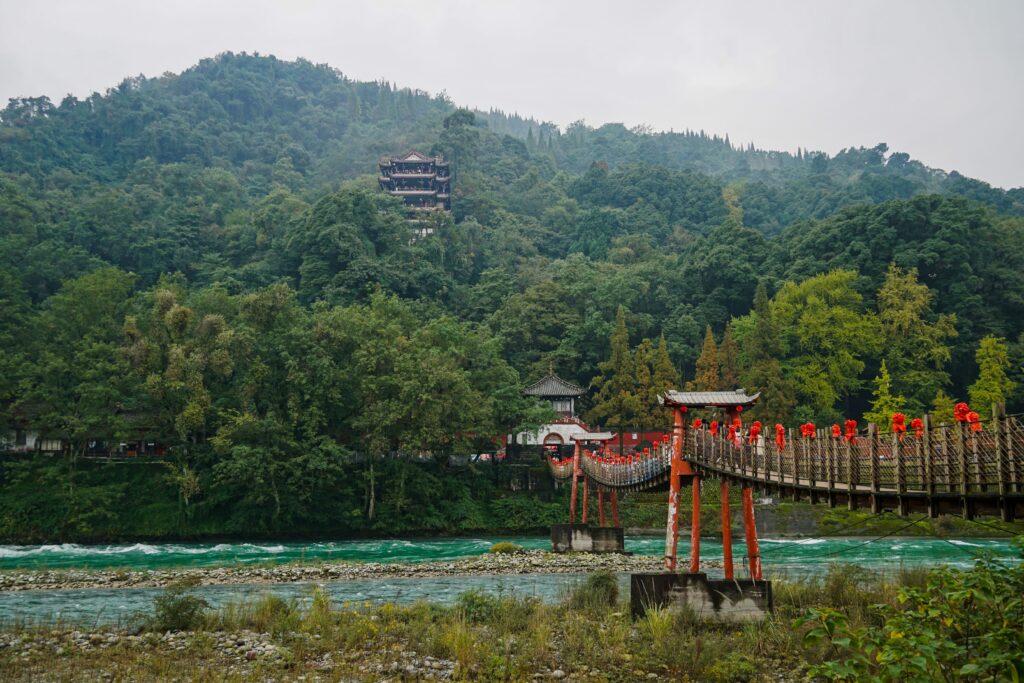
That evening, Kyle was relegated to eating non-spicy hot pot and other non-aggravating foods like rice cakes to try to fix his digestive issues. I ate the spicy hot pot and thoroughly enjoyed it.
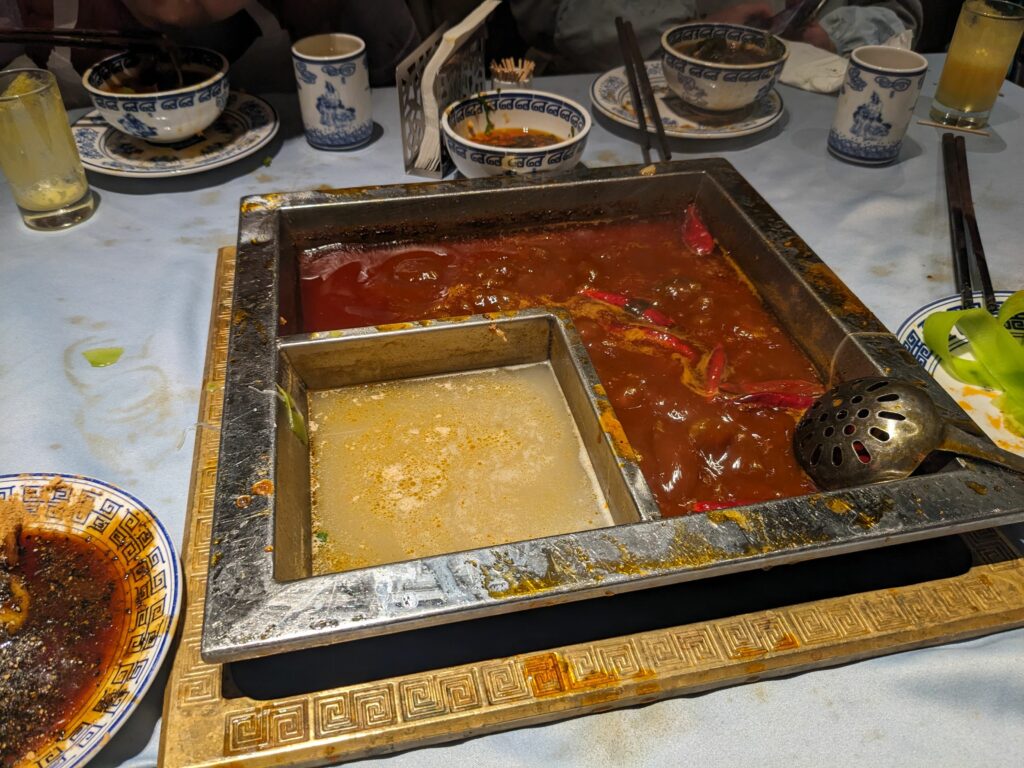
On our last day in Chengdu, we visited the famous Leshan Giant Buddha (乐山大佛). This time, we took an intercity high-speed train (C class), which still hits speeds of 200 km/h or more. Most of the people on this train seemed to be commuters.
The giant Buddha was carved over 1300 years ago and is 71m (233 feet) tall! To see the giant Buddha itself, you can either walk or take a boat tour. You probably get a better view of the whole Buddha from the boat, but it is really cool to stand next to the Buddha and pretend to “rub its nose for good luck.” You used to be able to walk down the cliff on the left side of the Buddha, which had amazing views all the way down, but they’ve changed the route to now go down stairs to the right of the Buddha, so you can’t actually see the whole giant Buddha as you’re going down the stairs.
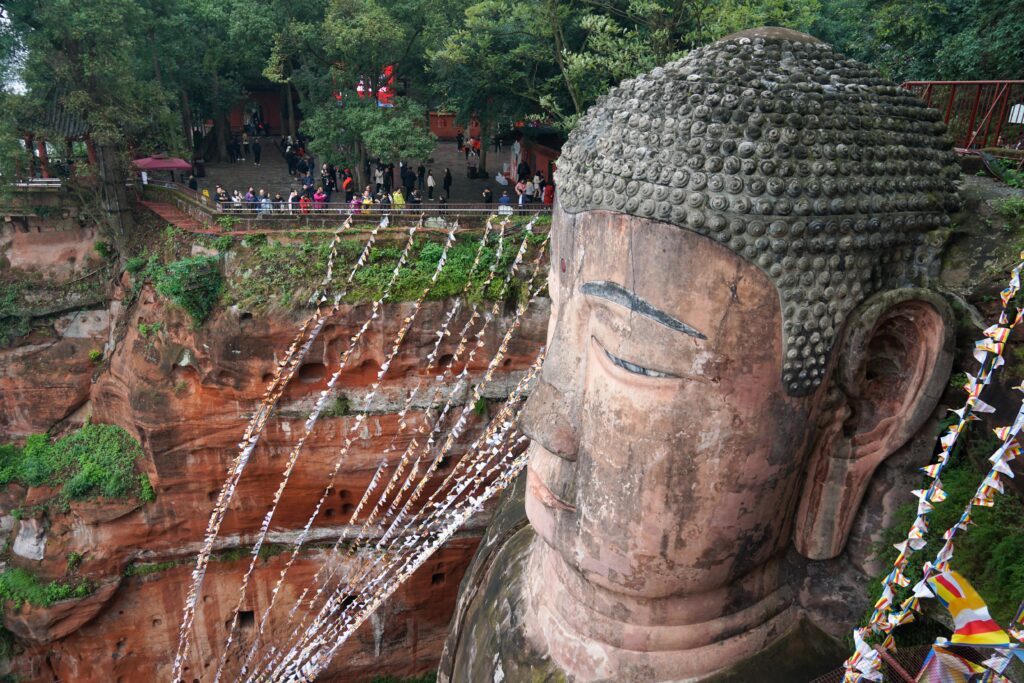

The new route back up from the giant Buddha also puts you at the entrance to a different scenic area, the “Oriental Buddha Capital” (东方佛都). This had a huge number of large Buddha statues and even the “hall of 10,000 Buddhas,” which had various scenes depicting events in the life of Buddha, with explanations in both Chinese and English. My favorite scene was one in which an evil spirit transformed into the shape of a beautiful woman to try to seduce Buddha, but he was so enlightened that he totally ignored her and was not seduced at all.
The Oriental Buddha Capital is actually quite a bit newer than the Giant Buddha – apparently these statues were carved by sculpture masters within the last 30 or 40 years or so, but it was still very cool! We also liked the 千手观音 (Thousand Hands Guanyin), which some of our friends commented would be an excellent aid station crew chief for an ultrarunner.
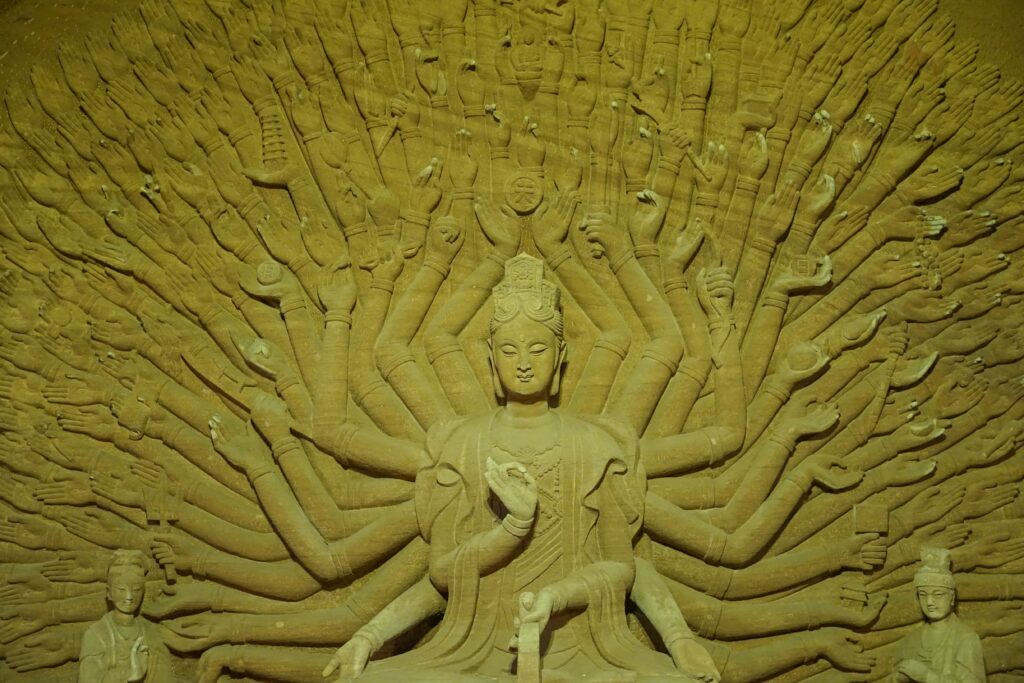
That night, we paid a visit to my great-aunt and great-uncle, who still live in the same apartment complex where my mom, her siblings, and her cousins grew up. My great-uncle excitedly asked me if I wanted to see “my mom’s earliest picture” – it was a picture of her at age 1! There were several other adorable baby pictures that my great-uncle tried to give to me, but I really thought it was better to keep those in the same photo album with all of the other old photos. So instead, I took pictures of them with my phone. I was actually quite surprised at how well the phone pictures turned out, given that these pictures were only like 3cm by 3cm to begin with.

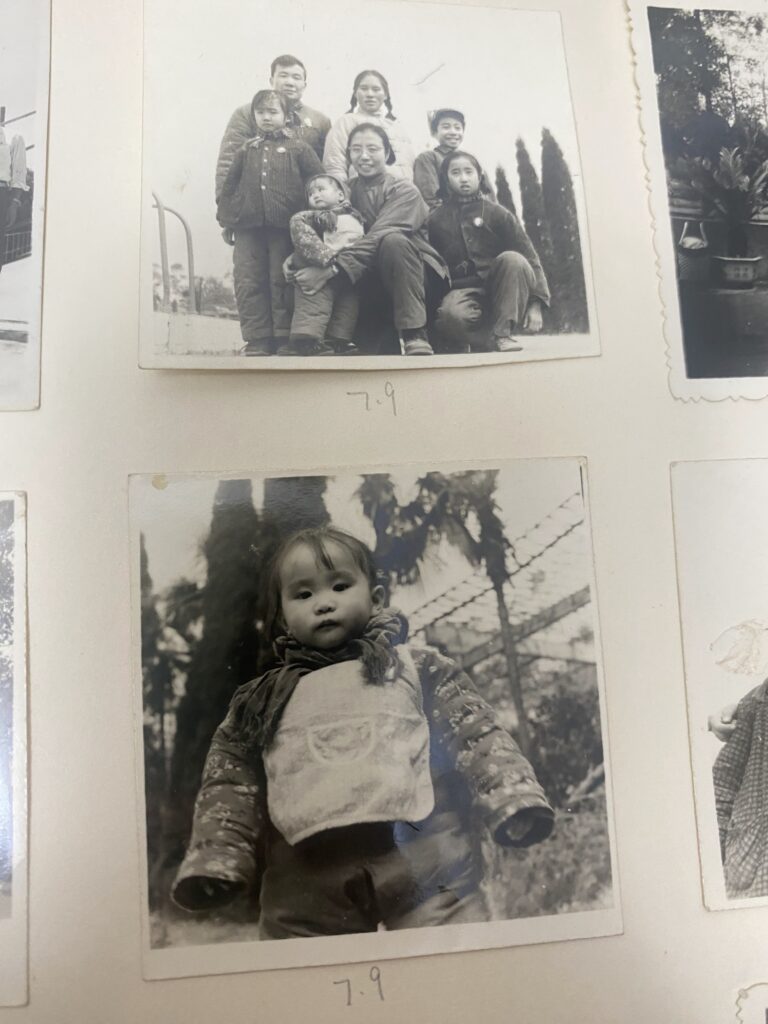
Kunming
Kunming appeared to be the only city in China that had direct flights to Phnom Penh, so we figured we could spend a few days there. We took a high-speed train (a real 高铁 [gaotie] this time), which was a very pleasant ride. Even though it was a bit longer and more expensive than a flight would have been, riding a train is such a more pleasant experience than riding an airplane. We thought there would be nice scenery on this train ride – my dad and I had taken an incredibly scenic train ride from Chongqing to Guiyang in 2018, and hoped that this ride would be similar.
Unfortunately, the scenery on this train ride wasn’t as good as it was back in 2018. Oh well.
After getting to our hotel, we decided to go on a little walk over to 西山 (West Mountain). Turns out that there was a pretty significant amount of vert there, all from stairs (over 1000 in total). There was also a walkway in the side of the cliff, which was super cool and unique! Kunming itself is at an elevation of over 6,000 ft, and at the top of this hike, we were at well over 7,000 ft. There are also lots of snowy mountains in Yunnan province, although we didn’t have time to visit them this time.

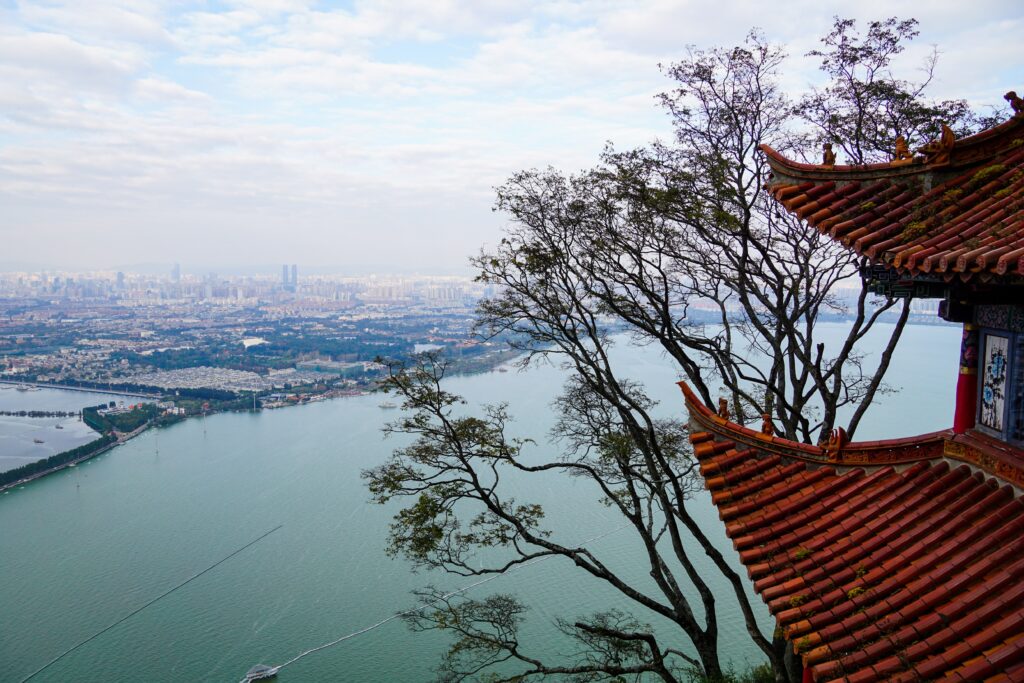
Kunming is the capital city of Yunnan Province, which is the southwestern-most province in China, and also the most ethnically diverse – 67% of the population is the Han Chinese majority (compared to 95% of China as a whole), and the remaining 33% comprise 25 of China’s 25 official ethnic minorities. We stayed near the “Yunnan Ethnicities Village” and spent a day exploring that, which was essentially a theme park showcasing the different architectural styles, music, dance, religious traditions, and traditional clothing of many different ethnic minorities in Yunnan.
It was actually pretty interesting – a highlight was one man playing nearly a dozen different indigenous musical instruments, including some kind of pipe where you smoke a cigarette while playing a flute. Many of the most touristy parts of Yunnan, like Dali and Lijiang, also are very heavily focused on “ethnic tourism,” where there is distinctive architecture and cultural “experiences” that are intriguing to Han Chinese.

We also spent a day touristing at the Stone Forest (石林), a distinctive landscape of karst limestone pillars. This area is sacred to the Yi ethnic minority. Some of the Yi people today perform their traditional dances and songs at the stone forest, and you can dress in their traditional clothing and get professional pictures taken for only ¥10 per person.
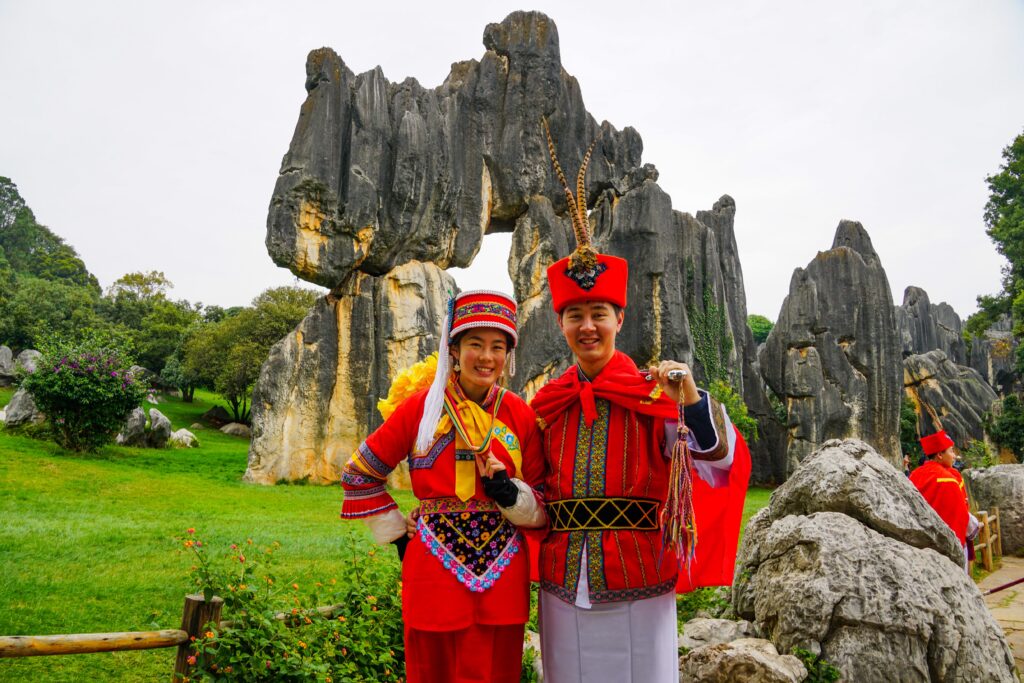
The main tourist area was incredibly crowded, especially this little viewing platform that had only one tiny staircase to go up, and an equally tiny staircase to go down. However, 100m outside the main stone forest scenic area, there was almost nobody to be found, and we walked around appreciating the cool rocks.
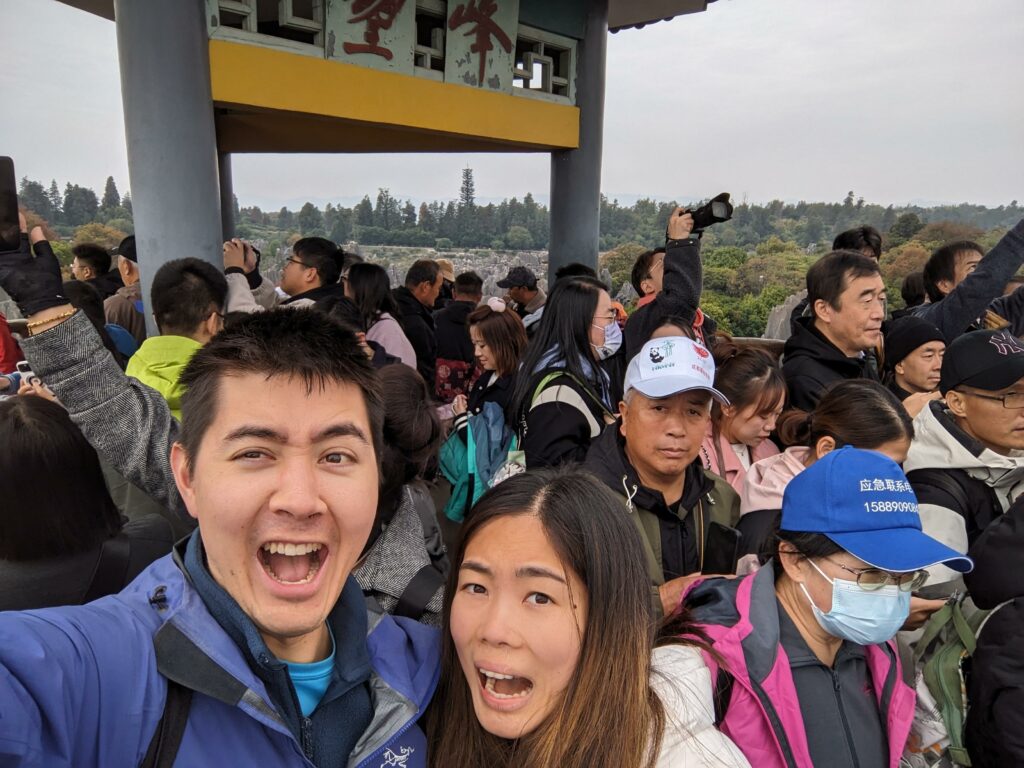

While in Kunming, we also watched a documentary called “Firsts” about The North Face runner Shen Jiasheng’s run at Western States in 2023. This was his first 100 miler, and his first time ever traveling in the U.S. Shen is actually from a rural village outside Kunming, so it was kind of cool to be watching this documentary from his actual hometown. We could easily see why Yunnan would be an excellent training ground for trail runners, with a year-round temperate climate and plenty of vert nearby.
While our time in Kunming was short, we felt like we’d done most of the stuff that was within a reasonable day trip of the city. If we went to Yunnan in the future, we’d spend more time in places like Lijiang or Dali which have more nature tourism and 雪山 (snowy mountains).
Cambodia (Kyle)
Phnom Penh
We arrived in Phnom Penh and within 5 minutes we had seen more white people than our entire time in China. As our taxi driver drove us to the airport, we marveled at the chaotic streets, filled with scooters sneaking through every weakness in the thick traffic, like a running back squeezing through the offensive line. Our driver taught us three words in Khmer (Cambodian language): “hello”, “goodbye”, and “thank you”.

Kelly and I went for a hot walk along the brown river as we waited for my parents to arrive. The hotel bathroom had the same smell as the water outside, but we quickly got used to it. My parents found us at the hotel and we were finally together after their travels in Vietnam and ours in China!

S-21 Genocide Museum
After lunch, our distant relative Piseth picked us up at the hotel to take us around Phnom Penh. I say “distant” relative because Piseth is my cousin’s cousin’s husband, meaning he doesn’t actually share any common ancestor with me. But we don’t have much other family left in Cambodia, or at least contact with any of them.
My mom was born in Phnom Penh, the third of eight straight sisters born, bookended by two brothers. My grandparents are ethnic Chinese, speaking the Chaozhou dialect, which my mom still uses with her sisters today. My mom was just a young teenager when the communist Khmer Rouge rolled into Phnom Penh on April 17, 1975 and my family was forced to flee to the countryside. For the next four years, they worked in the rice fields, struggling to survive at a time when about 2 million of the country’s 8 million people died. They were separated by age, but always managed to come back together. When the Khmer Rouge finally fell in January 1979, they escaped to a refugee camp in Thailand. A few months later, they were able to come to America.
The first spot Piseth took us to was the S-21 Genocide Museum. During the Khmer Rouge, they converted this former secondary school to a prison. Over a few years, over 18,000 prisoners were killed here. Almost none who ever entered survived. Today, it is memorialized to remember the victims. They left it mostly unchanged, with the original torture equipment, prison cells, and even some skulls left on display.

While miraculously none of my immediate family members died in the Khmer Rouge, we still carry the shared trauma of the brutal regime. Growing up, I would hear bits of stories here and there. As my aunts and uncles have gotten older, they have become more comfortable sharing, but many of them are still pained to remember. Hopefully, I will never be able to truly understand the horrifying period they went through, but walking through the former prison, I cried for the pain and suffering experienced by the victims of this prison, my family, and all of the Cambodian people.

I asked Piseth if they teach school children here about the Khmer Rouge. He said they certainly do, but not in as much detail as they could. For too many people, the Khmer Rouge is not just recent history; it is their lived experience. In many ways, the nation still has not moved on. There is so much sadness and depression. How do you move on from something so terrible?
Other Sites
Less than a mile from the genocide museum, we stopped by a street corner. This is where my mom’s house was before they had to abandon it in April 1975. Now, it was just a large concrete wall with something behind. My mom kept saying how much prettier the area was when they lived there, not so noisy and filled with concrete. I like to think this was a place of happy memories for her.

Across the street was her primary school. We walked over to the school and talked with some people hanging out there. Despite not using Khmer in the US for over 40 years, my mom still is basically fluent in Khmer. Whenever my mom told people that this was where she grew up, people lit up with a smile. And when they realized I was her son, they were doubly happy. Seeing the earnest smiles of the Cambodian people definitely made me feel more connected to my Cambodian identity.
Piseth was a wonderful guide for us and is a remarkable individual. He is in charge of nearly the entire country’s hydroelectric power and grid (Cambodia actually generates over 50% of its power from hydro). He was educated in Norway. We learned how he had saved his country hundreds of millions of dollars by strategizing when to use fossil fuels vs hydropower and anticipating how the Russia-Ukraine war would impact fuel prices. He is certainly an incredibly valuable person to Cambodia and I felt proud to be related to, even if very indirectly, someone like him.
Cambodian markets are very fun. There are tons of fresh tropical fruit and it is easy to get a freshly made smoothie on any street corner. After all her years in America, my mom is still fluent in Khmer. I could see how the smell of Durian or a freshly baked Cambodian donut brought about a quiet happiness in my mother and her oldest sister, who also joined us on our second day in Phnom Penh. There were endless mazes of street vendors, selling cheap clothes and discounted factory extras from Western brands. Although the merchants all spoke English, they would typically give my mom a special discount since she actually spoke Khmer.

While I have had some Cambodian food back home, this was my first time exploring a wider variety of dishes. Cambodian food is very similar to Thai food, but has some subtle differences. The signature ingredient is kroeung, a paste created by pounding together lime leaves, lemongrass, turmeric, galangal, and garlic. Since 60% of Cambodia’s protein as a country comes from a single lake, Tonlé Sap, many dishes feature fish. I really enjoyed Cambodian food! Just like China, each dish was excellent.

Siem Reap
From Phnom Penh, a driver drove us 5 hours to Siem Reap. Even though this is the largest highway in Cambodia, it still is just a narrow two lane road. We passed large trucks with dozens of people hanging off the back, rickshaws, and tractors. Cambodia’s infrastructure is incredibly primitive. Most roads are not paved.
Upon arriving in Siem Reap, we met Vandy, our tour guide. My parents knew him from their trip back in January. For the rest of the day and the next, we would tour the temples of Angkor.
Angkor
While Angkor Wat is the largest and most famous temple, Angkor in general represents the entire complex of historical temples and hydrological sites. From the 9th to 15th century, the Khmer Empire built dozens of temples and waterways. They were an advanced society, with extra capacity to create these giant temples, carved out of stone hauled from dozens of miles away. At one point, the ancient city was home to a million people, the largest city in the world at the time! Even today, only one city in Cambodia, Phnom Penh, is larger than that.
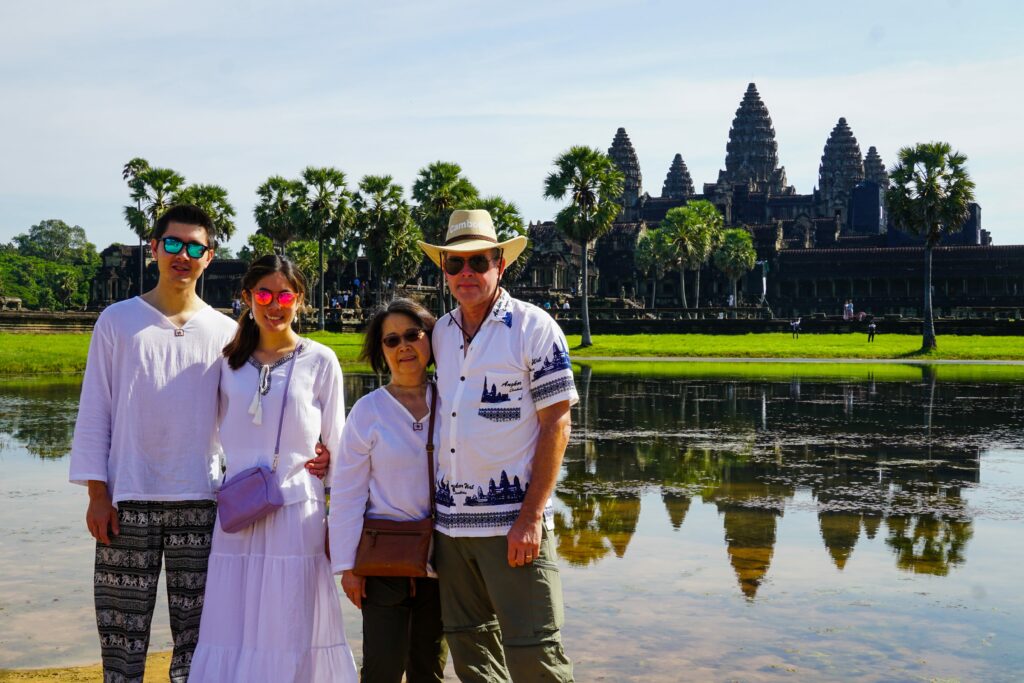

Angkor Wat was beautiful and grand, but my favorite temple was actually Ta Prohm. While all the temples were destroyed by powerful tree roots breaking apart the stone, Ta Prohm was carefully rebuilt in a way that retained some of the aesthetic, with beautiful trees crawling across the ancient stone.
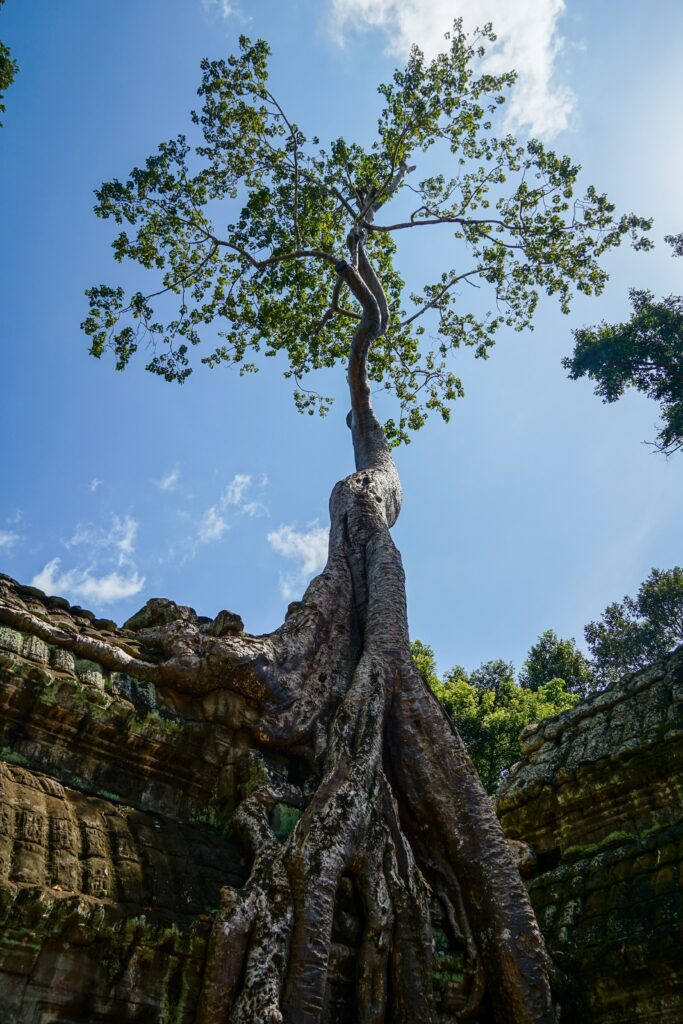
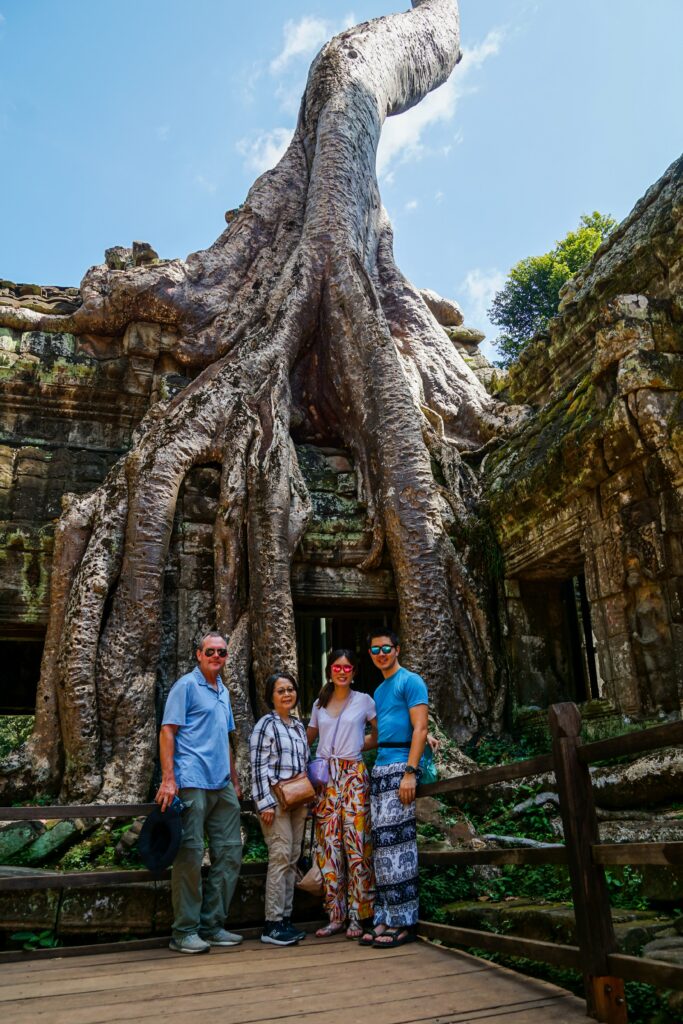
From our guide Vandy, we learned how the Khmer Empire oscillated between Hinduism and Buddhism. Vandy was extremely knowledgeable about Cambodia’s ancient history. He produces videos and teaches Cambodian students about the Khmer Empire. I could hear a lot of pride in his voice and I got the feeling that many Cambodians think of this powerful period in Cambodian history with a bit of nostalgia.

When Vandy’s knowledge was lacking, we filled the gaps with our mobile phones and the internet. Learning more about the decline of the Khmer Empire, we found out that the beginning of the Little Ice Age brought climatic shifts in Southeast Asia. The monsoons became less consistent with worsened big rain events. Rice farming became less productive, so farmers cut down more forests to expand their fields. As a result, more soil was washed away, clogging the canals that were critical to the city’s livelihood. While this was not the only cause of the Khmer Empire’s fall, it shows how intertwined climate and empires are.

Without the breeze of Phnom Penh, it was hot and humid in Siem Reap. But fortunately, there were plenty of freshly squeezed smoothies to drink and fresh coconut juice.

Vandy was a great guide and cares so deeply about his country! If you visit Phnom Penh, I recommend getting him as a guide! His website is https://www.vandytours.com/.
Pub Street
In the evenings, we took a tuk-tuk to Pub Street, the centerpiece of Western nightlife in Cambodia. Pub Street is a fun place, with all kinds of restaurants, cheap drinks, street food, and plenty of people trying to sell you stuff. For $2 (or $3 plus a beer), we could stick our feet in a pool of water where fish would eat the dead skin off our feet. It was incredibly ticklish at first, but after a while, it felt good.


There was a night market just outside Pub Street where we improved my wardrobe. Cambodian styled clothing is very flowy and thin – great for warm tropical climates like this one. But Kelly’s favorite purchase was a singing bowl. The shop owner taught us how to play it and Kelly kept coming back each night for more lessons.
Scooter Tour
On our last full day, Vandy took my dad and me for a scooter tour through the countryside. My dad has an adventure bike back home and rides in the mountains, but I had barely even used a motor scooter. I got a crash course (figuratively, not literally) as I followed Vandy through the chaotic streets of Siem Reap.

Once we got into the countryside, I was able to relax and enjoy the ride more. We stopped at some off-the-beaten-path ancient temples and chatted with locals. Vandy stopped us outside some rice fields and showed me how to harvest rice by hand, much like my mom did for years during the Khmer Rouge.

Outside the city, people are much poorer, often making only a few dollars per day. We could hear the desperation in their voices as they tried to sell us stuff, because we might be the only Westerners they see all day. It was hard to not want to help each and every one of them. I learned how to say “My mom is Cambodian” in Khmer, which always brought a big smile to the people. I’m not sure I have met more friendly people.
When my mom’s family walked to the Thai border after the fall of the Khmer Rouge, they were turned back by Thai soldiers. As the Thai soldiers drove the refugees back into Cambodia, the truck ran out of gas. When they finally got gas a few days later, the Red Cross had just announced that they were accepting Cambodian refugees in Thailand, so they reversed course and headed back to Thailand, and eventually America. My mom’s relatives who ventured to the Thai border one day earlier are still in the Cambodian countryside today. This is just one of countless examples of how tiny differences in choice and luck have created the life I have today in America. Just one day earlier, and I could be on the other side of this scooter tour, watching the Westerners ride by me.

Back to America (Kyle)
While the trip was a whirlwind of destinations in just two weeks, we both enjoyed it thoroughly and did not feel it was overly rushed. In the future, we want to take more time to travel in Asia, but that is always difficult with American work culture.
While the food was certainly a superficial highlight, the best part was certainly the people and culture. I loved watching Kelly converse with Chinese people, understanding even the idioms, jokes, and throwing in a few words in local dialects. And it was powerful to see where my mom grew up, the snacks she used to eat, and the school she used to attend.
For me, I felt like this trip was about better understanding my complex multi-cultural background. I don’t always know how to explain “what I am”, but I now better understand what it means to live with the legacy of the Khmer Rouge in my family. While I might not be ethnically Khmer, the kindness I experienced from the local people makes me feel more proud to say that I am Cambodian.

I have always loved your (insane) trip reports. This was such a refreshing change. It was so wonderful hearing about how the two of you connected with your heritage. I love reading your articles, even all the crazy ones describing things that I would never dare to do (partly because I am 71).
Thanks Dan, I wasn’t sure if people would enjoy the change of pace!
If I can write like you, I will be very happy, but where is my luck, in fact people like you are a good example for the world. You have written this beautiful Post very beautifully, I am very glad that I thank you from the bottom of my heart.
Thank you!